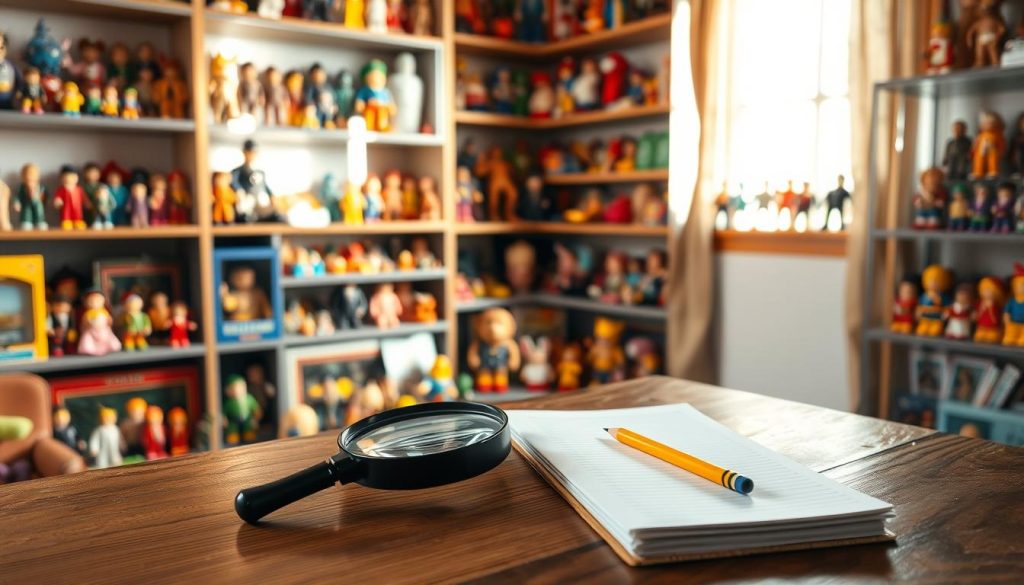Finding the resale price of a collectible toy means understanding a lot about it. You need to know the toy’s demand, its condition, how rare it is, and its history. With the right price estimate, you can do well in negotiations and make good profits. This is important for both new and experienced collectors to make smart choices in the toy resale market.
Figuring out a toy’s value means looking at its brand, model, and anything special about it. Also, checking sold prices of similar toys helps guess the selling price better. With the right knowledge, you can do well in selling your toys.
Key Takeaways:
- Understand the market demand and how it affects your toy’s resale value.
- Assess the condition and rarity of your collectible toy accurately.
- Utilize comparable sales data for an accurate price estimate.
- Leverage expert-driven methods for assessing toy value.
- Be prepared for knowledgeable negotiations with potential buyers.
Understanding the Toy Resale Market
The toy resale market is vibrant and exciting. It appeals to collectors and enthusiasts. Items range from old action figures to the latest limited editions. This market allows buyers and sellers to find and sell second-hand toys.
Overview of the Collectible Toy Market
The collectible toy market includes action figures, dolls, die-cast vehicles, and board games. Different toys attract different collectors. This affects pricing and value. The market has grown a lot and continues to thrive. Both new and old items are popular.
Factors Influencing Toy Value
Many factors affect a toy’s value.
- Rarity: Toys made in limited numbers are especially sought after.
- Condition: Toys that are almost new, especially in their original boxes, are worth more.
- Brand Reputation: Well-known brands like LEGO, Hot Wheels, and Barbie usually have higher values.
- Historical Significance: Toys with a history or tied to important events are more prized.
Knowing these factors helps with buying and selling second-hand toys.
Trends Affecting Prices
Trends in the toy market constantly change, influenced by nostalgia and pop culture. Toys from the ’80s and ’90s are now in demand. This is due to nostalgia. Also, special editions from franchises like Star Wars and Marvel are highly valued. It’s important to keep up with these trends for success in the collectible toy market.
Understanding these trends and factors means you can make smart choices in the toy resale market.
Researching Your Collectible Toy
Finding out the real value of a collectible toy requires careful study. By skillfully looking at brand, condition, and online info, you can nail the process. This ensures you know and boost your toy’s value.
Identifying Your Toy’s Brand and Model
First, you need to figure out the toy’s brand and model. Look for logos, marks, or serial numbers. This helps you see if it’s a rare or common toy. Finding toys from big names like Mattel, Hasbro, or LEGO can make them more valuable.
Checking Condition and Completeness
The toy’s condition and if it’s complete matter a lot for its value. Check for any damage, color changes, or missing pieces. Having the original box, manuals, and extras makes it worth more. Making a checklist helps during this check.
Utilizing Online Marketplaces
Online marketplaces are key for research and sales. Sites like eBay, Etsy, and forums offer great insights. They help you see prices and connect with collectors. They’re great for knowing the market and what you could get for your toy.
| Aspect | Description | Impact on Value |
|---|---|---|
| Brand Identification | Determining the manufacturer and series | High |
| Condition Assessment | Evaluating physical state and presence of wear | Moderate to High |
| Completeness | Includes original packaging and accessories | High |
| Online Marketplace Research | Using platforms to check prices and trends | Moderate |
Utilizing Price Guides and Resources
Figuring out a collectible toy’s resale value needs detailed research and solid info. Using trusted price guides, online databases, and selling platforms makes your value estimate more precise. Here’s how to best use these tools and resources.
Trusted Price Guide Sources
It’s important to consult well-known price guides for valuing your collectible toy. “Toy Collector’s Price Guide” and “Warman’s Field Guide to Toys” are key resources. They offer current pricing data, updated yearly. Pairing these guides with a toy depreciation calculator gives a deeper look into how your toy’s value changes over time.
Online Databases and Tools
Online tools and databases make valuing collectible toys easier in the digital age. Sites like PriceCharting and ToyWorth let you search for toys and see recent sales. Many sites also have a toy depreciation calculator, helping collectors see how their toy’s value might shift. These online options are handy and keep you informed with the latest prices.
Selling Platforms and Their Listings
Looking at current and old listings on sites like eBay, Mercari, and ToyWiz helps figure out a toy’s resale price. Archived listings give you a baseline for market value. Listings that show the sale price, toy condition, and completeness are key for your price estimate.
Making full use of price guides, digging into online databases, and checking out selling platforms leads to a good estimate of what a toy can sell for. This ensures sellers get a fair deal.
Analyzing Recent Sales Data
In the collectible toys world, checking out recent sales is key for guessing an item’s resale value. Looking at what’s been sold gives us a true view of the market and what buyers are willing to pay.
Importance of Sold Listings
Sold listings show real prices paid by collectors, setting them apart from hopeful prices. By looking at these sales, you get a real idea of what to expect for your collectible toy.
Tracking Auction Results
Auction data is super valuable for seeing value changes in the toy market. Watching recent auction results helps you understand price trends. This can shape how you decide to sell your toy.

Reviewing Social Media Marketplace Insights
Social media gives up-to-date info on collectible toys. Sites like Facebook Marketplace and Instagram share what’s currently popular. Keeping an eye on these can tell you what’s in demand.
| Data Source | Insights Provided |
|---|---|
| Sold Listings | Realized market prices |
| Auction Results | Pricing trends and fluctuations |
| Social Media Marketplaces | Current collectible toy trends |
Evaluating Your Toy’s Unique Features
Understanding your toy’s unique features is key in assessing its value. It helps accurately pinpoint the resale price.
Limited Editions and Rarities
Limited edition toys are highly prized in the collectible rarity market. Their limited production runs often lead to higher resale prices. For instance, a limited edition action figure from a popular series might be very sought after by collectors.
Packaging and Documentation
The toy’s original packaging and documentation boost its resale value. Items like authenticity certificates and original boxes increase its appeal. Collectors look for these because they prove the toy’s origin, making an unopened package more valuable.
Historical Significance
The historical background of a toy is crucial. If it influenced toy trends or is tied to important cultural events, its worth increases. Toys with such significance are valued more than ordinary toys due to their unique history.
| Feature | Impact on Resale Price |
|---|---|
| Limited Edition | High |
| Original Packaging | Medium to High |
| Historical Significance | High |
Setting a Competitive Resale Price
Finding the right price for a collectible toy is tricky. You need to look at market demand and your own profit. A good price strategy makes your item pop, draws in buyers, and boosts your earnings.
Balancing Price with Market Demand
First, check the current market for similar toys. See what people are paying. Look at your toy’s condition, rarity, and if it’s complete. A fair price makes your toy more inviting and boosts sale chances.
Timing Your Sale Strategically
The timing affects your toy’s resale value. Use big events or anniversaries to your advantage. Selling at the right time means your toy hits the market when demand is high, raising your profit chances.
Negotiating with Potential Buyers
Negotiation is crucial for a successful sale. Be ready to talk to buyers and stay open to compromise. Know your minimum price but consider fair offers. Balancing firmness and market savvy is key to a good deal.

